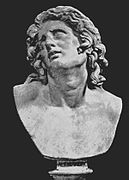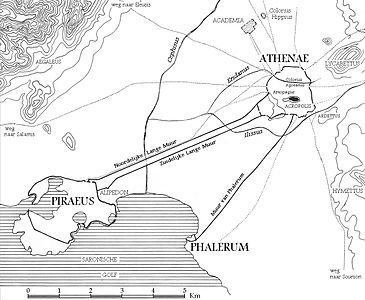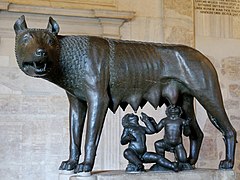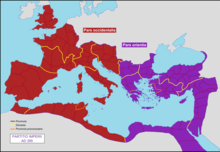Classical antiquity
The term Classical Antiquity is a historiographical expression to refer to the Greco-Roman period of the Ancient Age in Europe, a long historical period between High Antiquity (the time of the first civilizations of the Ancient Near East) and Low Antiquity (or Late Antiquity); and which properly corresponds to the Greco-Roman world: the Mediterranean Basin and the Near East, areas where ancient Greece and ancient Rome developed the Greco-Roman civilization. It is the period when both Greek and Roman societies flourished and exerted enormous influence throughout much of Europe, North Africa, and western Asia. The term "classical" means "greatest fullness" or "worthy model." of imitation", and its use to designate the period is markedly admiring, based on a later idealized vision of the time and its influence on the conformation of Western civilization.
Classical Antiquity can be located temporarily, in a restricted way, at the height of the Greek and Roman civilizations (V< century B.C. to II A.D.) or, broadly, throughout its duration (century 8th century BCE to V AD). Milestones of the beginning and end of this period are the Homeric poems, the first Olympic Games (776 BC) or the mythical foundation of Rome (753 BC) and Christianization (380 AD) or the fall of of the Western Roman Empire (476 AD) The spatial dimension of Classical Antiquity coincides with the Mediterranean basin, extended towards the Near East with the Empire of Alexander the Great and Hellenism, and towards Western Europe with the Roman Empire. Such a wide range of history and territory covers many disparate cultures and periods.
Ultimately, classical Antiquity survives and crosses the history of the West configuring a persistent morphology as well as a "theory" and an "idea".It can thus also refer to an idealized perspective among later peoples of what they were, in the words of Edgar Allan Poe, "the glory that was Greece and the majesty that was Rome". The classical cultural heritage survived even the so-called "dark centuries" of the High Middle Ages (500-1000 AD); and it will be revitalized with the Renaissance, Classicism and Neoclassicism of the Modern Age, reaching our days.
Archaic period (c. 8th to 6th centuries BC)
The earliest period of Classical Antiquity takes place against a background of a gradual reappearance of historical sources after the collapse of the Bronze Age. The VIII and VII a. C. are still largely protohistoric, with the earliest Greek alphabetic inscriptions appearing in the first half of the VIII century. Homer is generally assumed to have lived in the 8th or VII a. C., and his life is usually considered the beginning of classical antiquity. In the same period the traditional date of creation of the Olympic Games of Antiquity is located, in 776 a. c.
Phoenicians, Carthaginians and Assyrians
The Phoenicians originally expanded from the ports of Canaan, and by the 8th century they dominated trade in the Mediterranean. Carthage was founded in 814 BC. C., and the Carthaginians, for 700 a. C., had firmly established strongholds in Sicily, Italy and Sardinia, which created conflicts of interest with Etruria. A stele found in Citio (Cyprus) commemorates the victory of King Sargon II in 709 BC. C. over the seven kings of the island, which was an important step in the transfer of Cyprus from Tyrian rule to the Neo-Assyrian empire.
Greece
The Archaic period followed the Greek Dark Ages, witnessing major advances in political theory, the rise of democracy, philosophy, theater and poetry, as well as the revitalization of the written language (which had been lost during the Dark Ages).
In ceramics, the Archaic period sees the development of the orientalizing style, which signals a shift from the geometric style of the late Dark Ages and the accumulation of influences derived from Egypt, Phoenicia, and Syria.
Pottery styles associated with the latter part of the Archaic period are black-figure pottery, which originated in Corinth during the 17th century VII a. C. and its successor, the red-figure style, developed by the Andocides Painter around 530 BC. c.
Greek Colonies
Italy in the Iron Age
The Etruscans had established political control in the region by the late VII century BCE. C., forming the aristocratic and monarchical elite. The Etruscans apparently lost power in the area at the end of the VI century BCE. C. and, at that time, the Italic tribes reinvented their government by creating a republic, with much greater restrictions on the rulers' ability to exercise power.
Roman Kingdom
According to legend, Rome was founded on April 21, 753 BC. by the twin descendants of the Trojan prince Aeneas, Romulus and Remus. As the city was devoid of women, legend has it that the Latins invited the Sabines to a feast and stole their maidens, leading to integration of the Latins and the Sabines.
Indeed, archaeological evidence shows the first traces of settlement in the Roman Forum in the middle of the VIII century B.C. C., although settlements on the Palatine Hill may date back to the X century BCE. C.
The seventh and last king of Rome was Tarquin the Proud. Son of Tarquinio Priscus and son-in-law of Servius Tulio, Tarquinio the Proud was of Etruscan origin. It was during his reign that the Etruscans reached their height of power. Tarquinius closed and destroyed all the Sabine shrines and altars on the Tarpeian Rock, enraging the people of Rome. The people opposed his government when he did not acknowledge the rape of Lucrecia, a Roman patrician, at the hands of his own son. Lucrecia's relative, Lucius Junius Brutus (Marcus Brutus's ancestor), summoned the Senate and had Tarquin and the monarchy expelled from Rome in 510 BC. C. After the expulsion of Tarquinioo, the Senate voted in 509 a. C. that the government of a king would never be allowed again and he reformed Rome to convert it into a republican government.
Classical Greece
The classical period of ancient Greece corresponds to the centuries V century a. C. and IV century B.C. c.; as beginning and end milestones, from the fall of tyranny in Athens (510 BC) to the death of Alexander the Great (323 BC). The period called the Periclean century, in the middle of the V century, when a dazzling array of cultural creations in all spheres took place in Athens that nonetheless maintained the Hellenic tradition from the Archaic Period (VIII centuries to VI B.C.)
In 510 B.C. C., Spartan troops helped the Athenians opposed to the tyrant Hippias, son of Pisistratus. Cleomenes I, king of Sparta, put in his place a pro-Spartan oligarchy led by Isagoras, which in turn was removed from power with the reforms of Cleisthenes (508 BC), laying the foundations of what is known as democracy. Athenian.
The prolonged confrontation between the Greeks and the Persians (medic wars, 499-449 BC, until the Peace of Callias) resulted in the dominant position of Athens in the Delian League, a situation that was maintained during the long period of peace called Pentecontecia, but which led to a conflict with the Peloponnesian League, led by Sparta. The ensuing Peloponnesian War (431-404 BC) liquidated Athenian rule and established Spartan hegemony. In 395 B.C. C., the Spartan rulers removed Lysander from office and Sparta lost its naval supremacy. Athens, Argos, Thebes, and Corinth (the latter two formerly allied to Sparta) all challenged Spartan rule in the Corinthian War, which ended inconclusively in 387 BC. Later, the Theban generals Epaminondas and Pelopidas achieved a decisive victory in the Battle of Leuctra (371 BC), which meant the end of Spartan supremacy and the establishment of Theban hegemony, which was maintained until it was overshadowed by the growing power of the Kingdom of Macedonia.
The Macedonians, under the reign of Philip II, after expanding through the territories of the Paeonians, Thracians and Illyrians, intervened in Greece from 346 BC. C., culminating his conquest in the battle of Chaeronea (338 BC) and establishing his hegemony over a Hellenic confederation in which all the poleis participated except for Sparta (League of Corinth, 337 BC). The son of Philip, Alexander the Great, managed to defeat the Persian Empire (battles of Granicus, 334 BC, and Issus, 333 BC), incorporating all his domains, including the Egyptian Empire (siege of Gaza, 332 BC.), and even increasing in Central Asia and India (battle of the Hydaspes, 326 BC). Conventionally, the classical period ends with the death of Alexander in 323 BC. C. and the fragmentation of his empire, divided between the Diádocos.
Hellenistic period (330 to 146 BC)
The classical Greek period ended with the rise of the Macedonian kingdom and the conquests of Alexander the Great, ushering in the Hellenistic period. The koine became the lingua franca far beyond Greece itself, and Greek culture interacted with the cultures of Persia, Central Asia, India, and Egypt. In addition to the development of speculative thought (Hellenistic philosophy, particularly with the followers of Aristotle -Lyceum, peripatetic school, Aristotelianism-, those of Plato -Academy-, the Stoic and Epicurean schools, and the Alexandrian institutions -Museion and Library of Alexandria-), significant advances were made in sciences and techniques (geography and astronomy -Eratosthenes-, mathematics and physics -Archimedes-, etc.)
The Hellenistic period ended with the Roman conquest of Greece (146 BC), although some historians date its end with the Battle of Actium (31 BC), which marked the fall of Ptolemaic Egypt, the last kingdom remnant of the conquests of Alexander the Great.
Roman Republic (5th-1st century BC)

The republican period of Ancient Rome, which began with the overthrow of the Roman monarchy (509 BC), lasted for almost half a millennium until its subversion, after a series of civil wars, in a principality that opened the Imperial period (27 BC) During the Republic, Rome went from being a regional power in Latium to the dominant power in the Mediterranean. The unification of Italy under Roman hegemony was a gradual process, sparked by a series of conflicts in the 4th century and III: the Samnite wars, Latin wars and Pyrrhic wars. Roman victory in the Punic Wars and the Macedonian Wars established Rome as a supra-regional power for the II century a. C., followed by the acquisition of Greece and Asia Minor. This tremendous increase in power was accompanied by political instability and social unrest, factors that led to the Catiline conspiracy, the Social War, and the first triumvirate. As a result, the Roman Republic became the Roman Empire in the last half of the first century BC. c.
Roman Empire (1st century BC to 5th century AD)
Determining the precise end of the Roman republic is a disputed task for modern historians;[who?] Roman citizens at that time did not realize that the republic had ceased to exist. The first emperors, the Julio-Claudian dynasty, maintained the fiction of the survival of the republican institutions, although under the protection of their extraordinary powers, and the eventual return to their traditional form was maintained as a possibility. The Roman state continued to call itself Res publica as long as it maintained Latin as its official language, that is, longer than the very existence of the Western Roman Empire.
Rome had already acquired an imperial character (in terms of the dimension of its territorial domain) since the III century a. C. her victories against Carthage gave her control of Sicily and the east and south of Hispania; increased in the centuries II and I a. C. with the acquisition of the rest of Hispania, Africa (not the continent, but an area of the Mediterranean coast, centered in Carthage), Gaul, Illyria, Greece, Asia Minor, Syria and Judea. Egypt was the last republican conquest or the first imperial one, by the young Octavian, not yet exalted as Augustus (battle of Actium, 31 BC) at the time of the maximum extension of the Empire under the rule of Trajan (117 AD.), Rome controlled the entire Mediterranean Basin, as well as projecting north through Europe (Gaul, parts of Germany and Britain, the Balkans, Dacia) and east through the Caucasus and Mesopotamia.
Culturally, the Roman Empire was significantly Hellenized, but it also took on syncretic Eastern traditions, such as Mithraism, Gnosticism, and Christianity itself, which became dominant.
The secular decline of the Roman Empire began with the crisis of the third century.
Ancient Rome contributed greatly to the development of all kinds of features of Western civilization: law, institutions, warfare, art, architecture, engineering, literature, and languages themselves (not just Romance languages). derived directly from Latin, but also the highly influenced Germanic languages).
Contenido relacionado
History of Spanish constitutionalism
Village
Afghanistan













